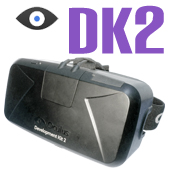
I previous reviewed the first consumer Oculus rift, and alluded to making a demo for it. Well, I did in fact make the Jerry’s Place demo for my first Oculus. Not too long after, the DK2 was released. After trying it at a trade show, I eventually caved and picked one up from Craigslist.
I’ll try to hit on the same points as my first review:
Screen Improvements / Screen Door Effect (SDE)
Firstly, the screen door effect is improved. The DK2 uses a pentile display, which in a nutshell means the pixels aren’t in a perfect square grid. Also, the resolution is higher. These two changes makes the rift a much more enjoyable experience. One downside to the higher resolution, is the increased need for PC performance. My desktop could handle the DK1 demos with no problem, but most demos struggle to run on my DK2, which is unfortunate.
Head Tracking
The biggest change is the addition of positional head tracking. The previous rift tracked your head – but only rotations. The DK2 tracks both rotation AND position. This is a huge improvement for immersion. Now you can duck, or peak around corners and the game / software will behave accordingly. On the DK1, ducking your real-life head would do nothing, which would confuse your brain, which was expecting the view to change. Now that the DK2 can track this element, the immersion is much more seamless. The downside, though, is that a special Oculus infrared camera must be pointed at the player at all times. For me this isn’t a huge issue since I intend on playing while sitting in a chair, but it does limit the mobility of the rift. It also makes an ugly cluttered mess – to set it up at my house, I have to put it on a tripod.
Immersion
This is the biggest bummer for me. While the higher resolution and the head tracking both improve immersion, the field-of-view was significantly reduced. On the DK1 you would have to look to the extreme left / right / up / down to see the edges of the screen. This really added to the immersion, because essentially your whole field of view was occupied. But the way the new version uses the screen, they weren’t able to get the same FOV. It feels like you have horse blinders on, and you can only really look forward. Looking with your eyes is a bit disappointing, because you’ll immediately be reminded of the edge of the screen.
Nausea
Partially because of the improved resolution, but primarily because of the head-tracking the Nausea problem is significantly improved. My roommate tried the previous rift and got sick almost immediately. When he tried my DK2, he was able to play for 15 or 20 minutes before wanting to quit. With that margin of time, it’s foreseeable that he could acclimate to it easily. Of course, the problem isn’t entirely eliminated but much improved.
Driver
The driver for the rift has changed somewhat, but not necessarily improved. It added a mode for “direct to rift.” What this means, is that it will let you run a program on your rift display without changing your monitor settings. This is super convenient. Unfortunately, graphics cards only support V-SYNC on the primary monitor. So games running in direct-to-rift mode suffer from lack of V-SYNC. To make matters worse, the rift actually uses the display at a 90 degree angle, so the tearing artifacts appear like a hack of H-SYNC (they appear vertical instead of horizontal), which easily makes you nauseous. While I applaud the effort to make it easier to use the rift, this method falls flat. I prefer to use the rift as an “Extended Display” and use my computers display/resolution settings to get it working. It’s a huge chore, but the games run correctly.
Software Support
At the time of this writing, there are far fewer DK2 demos / games than there are for the DK1. This is a bit disappointing because after owning it the only thing to do is to develop for it, which takes time. That’s a slight exaggeration, there are a few good demos out for it, but nowhere near the numbers of the first.
Conclusion
The worse field of view bothers me greatly. I really hope they fix this before the first consumer version. Other than that, it’s improvements in other areas are much welcomed. Clearly higher resolution is the only way to go forward, and the head tracking removes most of the nausea. Their method of using a camera might be limiting for mobility, but that’s not a huge concern of mine. I’d rather have perfect sitting VR, than imperfect mobile VR. The good news is that the Unity SDK now supports Oculus development in the free version… perhaps I’ll make something!
January 4, 2015 at 12:24 pm | Technology Reviews